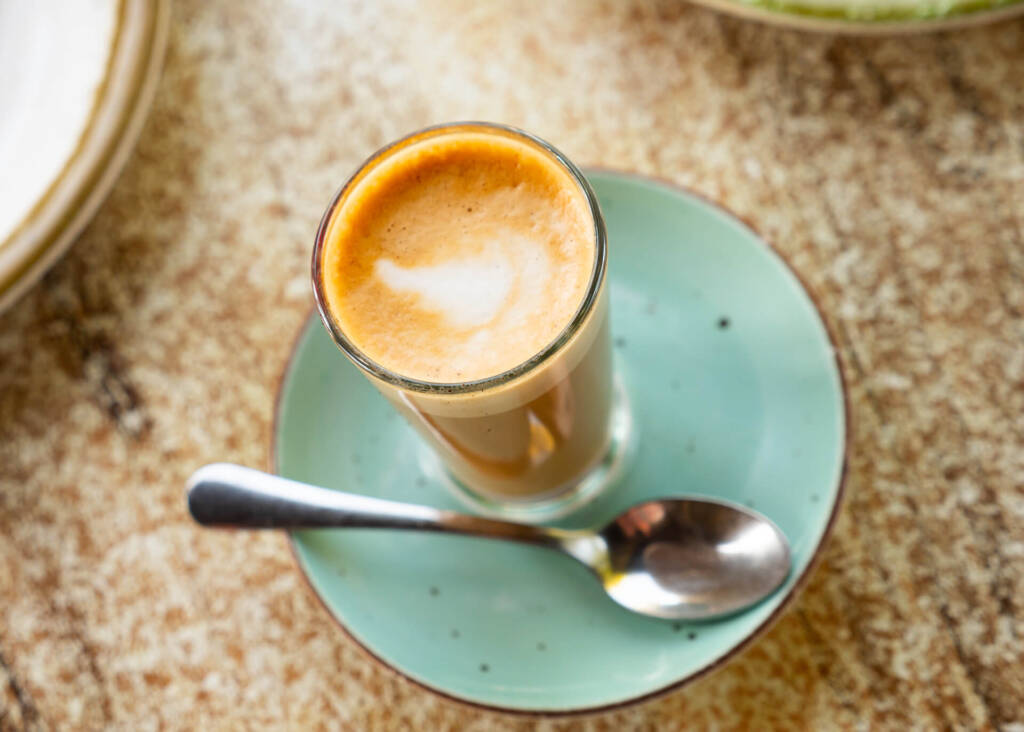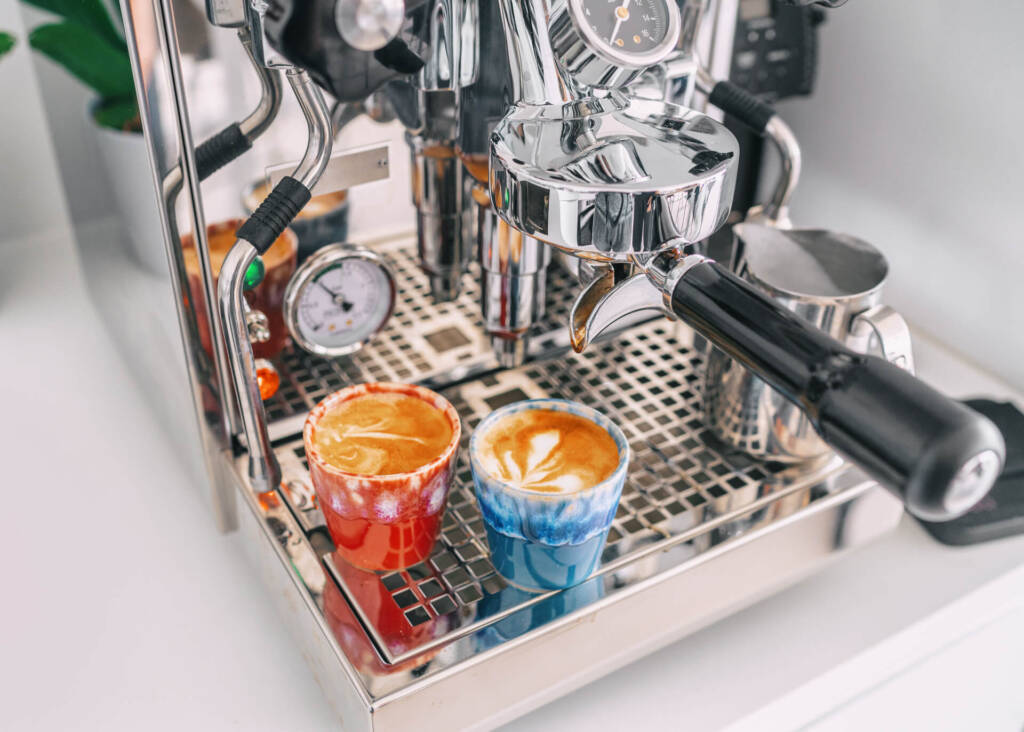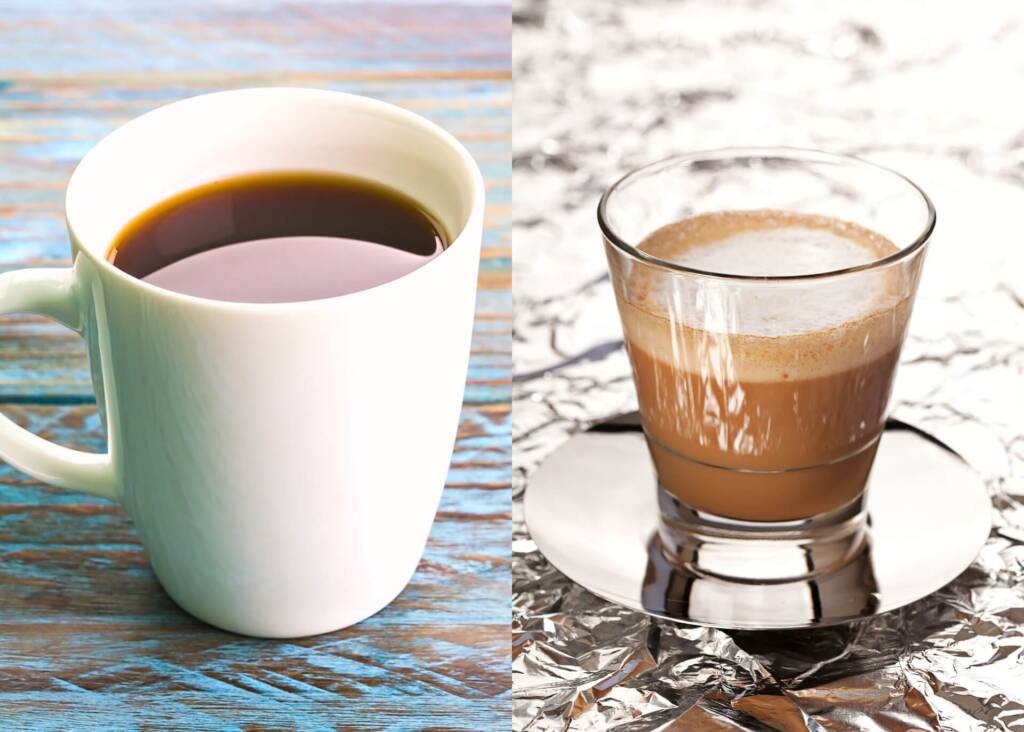When I went to a specialty coffee shop for the first time, I was confused by all the strange names on the menu. A cortado? An Americano? What on earth is the difference?
Cortado and Americano are popular coffee drinks, but the similarities end here. They offer pretty different coffee experiences — but both are delicious.
Read on and I’ll tell you everything you need to know about the differences (and similarities) of an Americano vs. cortado.
What is an Americano?
An Americano is a black coffee drink prepared by adding hot water to the espresso at a 2:1 ratio. It has its roots in the coffee traditions of both Italy and the U.S. (what a surprise!). While Italians invented espresso, the base of this coffee drink, Americans decided to dilute it with hot water to make it smoother on their palate.
The traditional Americano isn’t particularly large, consisting of a single espresso shot mixed with twice the amount of hot water. However, the drink has taken on a life of its own and you can find much larger Americanos in coffee shops like Starbucks today.
Yet, the size of the drink doesn’t matter. You can use a double or even a triple shot of espresso. As long as you get the ratio of espresso to water right, you’ve made an Americano!
Well, the order of mixing matters, too. If you add the coffee last, you’ve made a long black — an Australian take on the American favorite. And if you pour espresso over sparkling water, you have a summer’s favorite sparkling Americano!

What is a cortado?
The cortado is a popular Spanish coffee drink prepared by mixing equal parts espresso and steamed milk.
A cortado is often confused with other coffee drinks with milk, like cappuccino, macchiato, or a flat white. But the 1:1 coffee-to-milk ratio sets the cortado apart from the others.
A cortado has less foam on top, while cappuccinos have a very thick head of foam. A macchiato has much less milk than a cortado, while a flat white has more milk than a cortado.
But if you ask me, what makes cortado unique is that it’s a perfectly balanced coffee drink with a bold espresso taste and a smooth, creamy texture from the steamed milk.

Americano vs. cortado: key differences
You now know the basic details of Americano and cortado and how they compare to similar coffees. But how do they square up against each other?
The only similarities they share are that they contain espresso, and their names end in O. I’ve detailed the main differences between the Americano vs. cortado below.
Origin
The first key difference between Americano and cortado is where they originated from. Americano is an American invention, while the cortado originates from Spain.
A popular story recounts Americano coffee’s roots during World War II. At the time, American soldiers stationed in Europe fueled their fighting spirits by guzzling huge amounts of coffee.
However, the Americans were used to drip coffee. They found the espresso served at Italian cafes much too bitter and too strong for their tastes.
How is a coffee-starved soldier supposed to get his fix? Easy — the G.I.s diluted their espresso shots with hot water to tone down the bitterness, and so the Americano was born!
It’s a compelling story, but it might, unfortunately, not be entirely true. We can find references to Americano coffee way before World War II.
That doesn’t mean the war-time tale is wholly made up, though. Americano may have existed before the conflict — but the American soldiers could have made the drink popular by bringing it over the Atlantic with them!
The cue to the origin of cortado is in its name. “Cortado” comes from the Spanish word “cortar,” which means “to cut.”
Essentially, the name refers to how the steamed milk “cuts” through the coffee to dilute the concentrated espresso shot.
A cortado (or something very similar) was likely first made in the Basque Country in northern Spain, but the drink wasn’t called a cortado then. The first known use of “cortado” comes from a Barcelona coffee shop manual from 1926.
Today, you can see cortado on the menu in coffee shops all over the world. Its popularity has resulted in many variations from other countries.
These include the Cuban cortadito (made with condensed milk), the Australian piccolo latte (prepared with a single shot of ristretto), and the American Gibraltar (a slightly larger cortado served in a special Libbey glass).

Ingredients
The Americano and cortado are relatively simple espresso-based drinks, but their ingredients are the main difference. An Americano consists of espresso and hot water, while a cortado mixes espresso with a small amount of steamed milk.
For a drink made with only coffee and water, Americano can be a surprisingly complex brew. The main variables with an Americano are the espresso-to-water ratio and the order of preparation.
A barista preparing a traditional Americano will use a 1:2 ratio of coffee to water — in other words, twice as much water as coffee. That said, it’s not uncommon for a cafe to offer Americanos made with more water at 1:1 or even 2:1 ratios.
Typically, an Americano is made by adding hot water over a shot of espresso. However, the long black — a popular Australian drink variation — is brewed by pouring espresso into hot water. This technique preserves the crema better, which is why some coffee enthusiasts prefer it.
The hot water used for an Americano can be boiled in a separate kettle or drawn directly from the espresso machine. Most cafes prefer the latter method as it gives the resulting drink a more stable temperature and doesn’t require additional equipment.
Finally, you shouldn’t confuse the Americano with cafe lungo. A lungo also uses the same ingredients, but it’s made by running more pressurized water through finely-ground coffee beans in the espresso machine. The extended brew time extracts more bitter notes into the lungo when compared to an Americano.
Cortado is brewed by mixing espresso-style coffee with steamed milk at a 1:1 coffee-to-milk ratio. One of the cortado’s most defining features is how much milk it contains.
Another significant factor that sets a cortado apart from similar types of coffee drinks is the level of steaming used to prepare the milk.
The milk is steamed for a cortado until warm, distinguishing it from a white coffee (made with cold milk) and a cafe au lait (made with heated but not steamed milk). However, the barista doesn’t let the milk become frothy, differentiating the cortado from the cappuccino.
Additionally, a cortado is never served with coffee add-ins like cinnamon, cocoa powder, or chocolate syrup.
That said, this is all up to your personal preferences! If you enjoy a sprinkle of cinnamon over your cortado, don’t let anyone stop you!

Serving size
A cortado is typically served in a small 4 fl oz. (118 ml) glass or cup, while the Americano’s serving sizes start with 8 fl oz. (240 ml).
However, there is no actual standard Americano serving size. This is mostly because the drink’s defining characteristic is the 1:2 ratio of espresso to hot water — not how large the brew is.
You can make an Americano with as much or as little espresso as you like. Using the conventional measurements, one shot of espresso (1 fl oz./30 ml) results in a 3 fl oz. (90 ml) drink, while a double shot (2 fl oz./60 ml) pushes the serving size to 6 fl oz. (180 ml).
Considering how Americano (supposedly) was brewed to imitate a cup of drip coffee, we can assume the brew from WWII-era Italy was made with two espresso shots. However, 6 oz. is still quite a small serving of regular coffee, so I wouldn’t be surprised if the Italian baristas used a triple shot.
Over the years, Americanos have grown in size. The smallest Americano served in modern coffee shops is usually 8 fl oz. (240 ml) which would require roughly three shots of espresso.
The drinks can be much larger, though. Starbucks, for example, offers a gigantic 20 fl oz. (600 ml) Venti Americano!
In contrast to Americano, cortado’s serving size is standardized across most cafes. This is due to the traditional glass in which it was served.
Although many shops today replace the original glass with a small cup, the cortado is still made with a double shot of espresso. Since the straight espresso is always cut with milk in a 1:1 ratio, the resulting drink measures 4 fl. oz — filling the glass.
Here’s a fun fact. The glass cortado is served in was originally meant for drinking carajillo — an alcoholic Spanish coffee drink commonly enjoyed as a shot. That explains the cortado’s small serving size!

Taste
These two are very different types of coffee drinks regarding the flavor experience. An Americano has a strong and bold flavor, while a cortado is a more balanced drink with a creamy, velvety texture and some sweetness.
Since Americano doesn’t contain milk, it retains much of the original espresso flavor. The taste is often rather intense and can carry more or less of espresso’s bitter notes, depending on the amount of water used to prepare it.
Compared to most other espress0-based drinks, an Americano has a simpler flavor profile. That’s not a bad thing, though — I really enjoy the down-to-the-basic taste of Americano on the go.
One thing that Americano lacks in comparison to espresso is the texture. The added hot water naturally gives the coffee a thinner, lighter, and almost watery mouthfeel.
A cortado provides a creamy and smooth mouthfeel due to equal parts espresso and steamed milk. Since it has less milk than many other espresso-based drinks, the coffee flavor is stronger than in, say, a cappuccino. It can also retain some of the espresso’s acidity.
At the same time, the steamed milk adds sweet hints to the drink that may remind you of a cafe latte. It also adds plenty of creaminess, making the cortado a smooth-textured brew.
The half-coffee, half-milk recipe combines a rich and well-balanced treat with a deliciously thick texture.
Just because their flavors are very different doesn’t mean you always have to go for the same coffee, though! Even if you prefer one over the other, an Americano and a cortado can be great in different situations.
For example, I often order an Americano when I need something bold to kick me awake in the morning or I want to sip on while reading a book. Meanwhile, a cortado is an excellent option for a small treat after lunch or a quick coffee at the shop counter while running my errands.

Caffeine content
Generally, your average Americano and cortado are made with two espresso shots, giving them a similar caffeine content of around 120-130 mg per cup.
The caffeine content may vary when you order your drink in different coffee shops. Let’s start with both brews’ basic building block to understand how this works — an espresso shot.
Based on USDA data, a single espresso shot contains roughly 63 milligrams of caffeine. This can vary depending on the roast level and types of coffee beans used in the espresso blend, but we can use it as a handy guideline.
Another important thing to know is that additives — milk or water — don’t lower the amount of caffeine. No matter what you add, caffeine in your coffee stays constant.
As you’ve learned, a modern cortado is generally made with a double espresso containing 126 mg of caffeine. If you made an Americano with the same amount of coffee, the two drinks would have a similar strength.
Most cafes today use a double espresso, even if the smallest cup of Americano they offer is 8 fl oz. However, strictly speaking, this is a bit weaker drink than what the traditional 1:2 Americano ratio would produce.
If you follow the 1:2 brew ratio to a tee (like when making Americano at home), a small 8 fl oz Americano should contain a bit over two-and-a-half shots of espresso. Basic math tells us this brew has around 164 mg of caffeine, making it a slightly stronger coffee than a cortado.
Of course, the best coffee is always made to your taste. Most baristas will accommodate a special coffee order, increase the serving size, or alter the brew ratios to your preferences.
So, if you want more caffeine from a cortado, you can ask for three shots of espresso in it. And if a regular Americano just isn’t strong enough for you, ask for a 2:1 espresso-to-water ratio for an even higher concentration of caffeine — or get a bigger drink!
There you have it — everything you need to know about the differences between an Americano and a cortado. They are rather different types of coffee, but both are delicious!
With this explanation, you should now be able to easily decide which drink is more likely to please your taste buds. And if you are used to having one over the other, why not try something new with your next visit to your favorite coffee shop?
You just might be pleasantly surprised!
